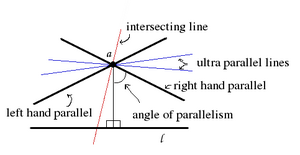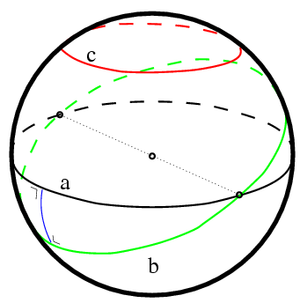|
Parallel (geometry)
 In geometry, parallel lines are coplanar infinite straight lines that do not intersect at any point. Parallel planes are planes in the same three-dimensional space that never meet. Parallel curves are curves that do not touch each other or intersect and keep a fixed minimum distance. In three-dimensional Euclidean space, a line and a plane that do not share a point are also said to be parallel. However, two noncoplanar lines are called skew lines. Line segments and Euclidean vectors are parallel if they have the same direction or opposite direction (not necessarily the same length).[1] Parallel lines are the subject of Euclid's parallel postulate.[2] Parallelism is primarily a property of affine geometries and Euclidean geometry is a special instance of this type of geometry. In some other geometries, such as hyperbolic geometry, lines can have analogous properties that are referred to as parallelism. SymbolThe parallel symbol is .[3][4] For example, indicates that line AB is parallel to line CD. In the Unicode character set, the "parallel" and "not parallel" signs have codepoints U+2225 (∥) and U+2226 (∦), respectively. In addition, U+22D5 (⋕) represents the relation "equal and parallel to".[5] Euclidean parallelismTwo lines in a planeConditions for parallelism Given parallel straight lines l and m in Euclidean space, the following properties are equivalent:
Since these are equivalent properties, any one of them could be taken as the definition of parallel lines in Euclidean space, but the first and third properties involve measurement, and so, are "more complicated" than the second. Thus, the second property is the one usually chosen as the defining property of parallel lines in Euclidean geometry.[6] The other properties are then consequences of Euclid's Parallel Postulate. HistoryThe definition of parallel lines as a pair of straight lines in a plane which do not meet appears as Definition 23 in Book I of Euclid's Elements.[7] Alternative definitions were discussed by other Greeks, often as part of an attempt to prove the parallel postulate. Proclus attributes a definition of parallel lines as equidistant lines to Posidonius and quotes Geminus in a similar vein. Simplicius also mentions Posidonius' definition as well as its modification by the philosopher Aganis.[7] At the end of the nineteenth century, in England, Euclid's Elements was still the standard textbook in secondary schools. The traditional treatment of geometry was being pressured to change by the new developments in projective geometry and non-Euclidean geometry, so several new textbooks for the teaching of geometry were written at this time. A major difference between these reform texts, both between themselves and between them and Euclid, is the treatment of parallel lines.[8] These reform texts were not without their critics and one of them, Charles Dodgson (a.k.a. Lewis Carroll), wrote a play, Euclid and His Modern Rivals, in which these texts are lambasted.[9] One of the early reform textbooks was James Maurice Wilson's Elementary Geometry of 1868.[10] Wilson based his definition of parallel lines on the primitive notion of direction. According to Wilhelm Killing[11] the idea may be traced back to Leibniz.[12] Wilson, without defining direction since it is a primitive, uses the term in other definitions such as his sixth definition, "Two straight lines that meet one another have different directions, and the difference of their directions is the angle between them." Wilson (1868, p. 2) In definition 15 he introduces parallel lines in this way; "Straight lines which have the same direction, but are not parts of the same straight line, are called parallel lines." Wilson (1868, p. 12) Augustus De Morgan reviewed this text and declared it a failure, primarily on the basis of this definition and the way Wilson used it to prove things about parallel lines. Dodgson also devotes a large section of his play (Act II, Scene VI § 1) to denouncing Wilson's treatment of parallels. Wilson edited this concept out of the third and higher editions of his text.[13] Other properties, proposed by other reformers, used as replacements for the definition of parallel lines, did not fare much better. The main difficulty, as pointed out by Dodgson, was that to use them in this way required additional axioms to be added to the system. The equidistant line definition of Posidonius, expounded by Francis Cuthbertson in his 1874 text Euclidean Geometry suffers from the problem that the points that are found at a fixed given distance on one side of a straight line must be shown to form a straight line. This can not be proved and must be assumed to be true.[14] The corresponding angles formed by a transversal property, used by W. D. Cooley in his 1860 text, The Elements of Geometry, simplified and explained requires a proof of the fact that if one transversal meets a pair of lines in congruent corresponding angles then all transversals must do so. Again, a new axiom is needed to justify this statement. ConstructionThe three properties above lead to three different methods of construction[15] of parallel lines. 
Distance between two parallel linesBecause parallel lines in a Euclidean plane are equidistant there is a unique distance between the two parallel lines. Given the equations of two non-vertical, non-horizontal parallel lines, the distance between the two lines can be found by locating two points (one on each line) that lie on a common perpendicular to the parallel lines and calculating the distance between them. Since the lines have slope m, a common perpendicular would have slope −1/m and we can take the line with equation y = −x/m as a common perpendicular. Solve the linear systems and to get the coordinates of the points. The solutions to the linear systems are the points and These formulas still give the correct point coordinates even if the parallel lines are horizontal (i.e., m = 0). The distance between the points is which reduces to When the lines are given by the general form of the equation of a line (horizontal and vertical lines are included): their distance can be expressed as Two lines in three-dimensional spaceTwo lines in the same three-dimensional space that do not intersect need not be parallel. Only if they are in a common plane are they called parallel; otherwise they are called skew lines. Two distinct lines l and m in three-dimensional space are parallel if and only if the distance from a point P on line m to the nearest point on line l is independent of the location of P on line m. This never holds for skew lines. A line and a planeA line m and a plane q in three-dimensional space, the line not lying in that plane, are parallel if and only if they do not intersect. Equivalently, they are parallel if and only if the distance from a point P on line m to the nearest point in plane q is independent of the location of P on line m. Two planesSimilar to the fact that parallel lines must be located in the same plane, parallel planes must be situated in the same three-dimensional space and contain no point in common. Two distinct planes q and r are parallel if and only if the distance from a point P in plane q to the nearest point in plane r is independent of the location of P in plane q. This will never hold if the two planes are not in the same three-dimensional space. In non-Euclidean geometryIn non-Euclidean geometry, the concept of a straight line is replaced by the more general concept of a geodesic, a curve which is locally straight with respect to the metric (definition of distance) on a Riemannian manifold, a surface (or higher-dimensional space) which may itself be curved. In general relativity, particles not under the influence of external forces follow geodesics in spacetime, a four-dimensional manifold with 3 spatial dimensions and 1 time dimension.[16] In non-Euclidean geometry (elliptic or hyperbolic geometry) the three Euclidean properties mentioned above are not equivalent and only the second one (Line m is in the same plane as line l but does not intersect l) is useful in non-Euclidean geometries, since it involves no measurements. In general geometry the three properties above give three different types of curves, equidistant curves, parallel geodesics and geodesics sharing a common perpendicular, respectively. Hyperbolic geometry While in Euclidean geometry two geodesics can either intersect or be parallel, in hyperbolic geometry, there are three possibilities. Two geodesics belonging to the same plane can either be:
In the literature ultra parallel geodesics are often called non-intersecting. Geodesics intersecting at infinity are called limiting parallel. As in the illustration through a point a not on line l there are two limiting parallel lines, one for each direction ideal point of line l. They separate the lines intersecting line l and those that are ultra parallel to line l. Ultra parallel lines have single common perpendicular (ultraparallel theorem), and diverge on both sides of this common perpendicular.
Spherical or elliptic geometry In spherical geometry, all geodesics are great circles. Great circles divide the sphere in two equal hemispheres and all great circles intersect each other. Thus, there are no parallel geodesics to a given geodesic, as all geodesics intersect. Equidistant curves on the sphere are called parallels of latitude analogous to the latitude lines on a globe. Parallels of latitude can be generated by the intersection of the sphere with a plane parallel to a plane through the center of the sphere. Reflexive variantIf l, m, n are three distinct lines, then In this case, parallelism is a transitive relation. However, in case l = n, the superimposed lines are not considered parallel in Euclidean geometry. The binary relation between parallel lines is evidently a symmetric relation. According to Euclid's tenets, parallelism is not a reflexive relation and thus fails to be an equivalence relation. Nevertheless, in affine geometry a pencil of parallel lines is taken as an equivalence class in the set of lines where parallelism is an equivalence relation.[18][19][20] To this end, Emil Artin (1957) adopted a definition of parallelism where two lines are parallel if they have all or none of their points in common.[21] Then a line is parallel to itself so that the reflexive and transitive properties belong to this type of parallelism, creating an equivalence relation on the set of lines. In the study of incidence geometry, this variant of parallelism is used in the affine plane. See also
Notes
References
Further reading
|

















